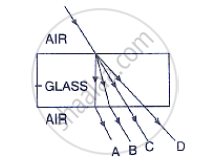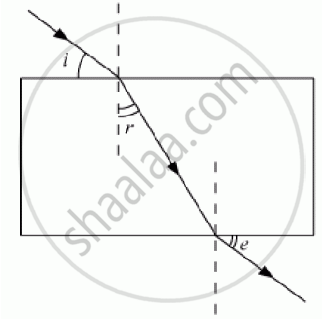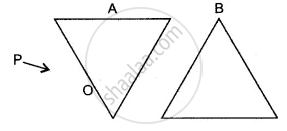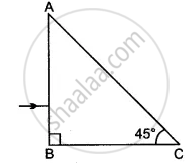Advertisements
Advertisements
Question
Define refraction and state the laws of refraction.
Solution
The phenomenon of change in the direction of propagation of light when it passes obliquely from one transparent medium to another is called refraction of light.
Laws of refraction:-
- The incident ray and the refracted ray are on the opposite sides of the normal at the point of incidence, and all three lie in the same plane.
- For a given pair of media, the ratio of the sine of the angle of incidence to the sine of the angle of refraction is constant.
`sin i/sin r=mu`
This constant is called the refractive index of the second medium with respect to the first medium.
APPEARS IN
RELATED QUESTIONS
When a ray of light travels from air to glass slab and strikes the surface of separation at 90°, then it …………….
(a) bends towards normal
(b) bends away from normal
(c) passes unbent
(d) passes in zigzag way
Which colour of light travels fastest in any medium except air?
Why is the ratio of the velocities of light of wavelengths 4000Å and 8000Å in vacuum 1: 1?
The following diagram shows a 60°, 30°, 90° glass prism of critical angle 42°, Copy the diagram and complete the path of incident ray AB emerging out of the prism marking the angle of incidence on each surface.

A ray of light strikes the surface of a rectangular glass block such that the angle of incidence in
air is 0°.
In each case, draw diagram to show the path taken by the ray as it passes through the glass block and emerges from it.
When a lighted candle is held in front of a thick plane glass mirror, several images can be seen, but the second image is the brightest, give reason.
A ray of light is passing from a transparent medium 1 to another transparent medium 2 (i) Speed up (ii) slows down. In each case, state whether the refractive index of medium 2 is equal to, less than or greater than the refractive index of medium 1.
In fig 4.18, name the ray which represents the correct path of light while emerging out through a glass block.

An object is viewed through a glass prism with its vertex pointing upwards. It appears to be displaced upward. Explain the reason.
A postage stamp kept below a rectangular glass block of refractive index 1.5 when viewed from vertically above it, appears to be raised by 7.0 mm. Calculate the thickness of the glass slab.
The critical angle for glass-air is 45° for the light of yellow colour. State whether it will be less than, equal to, or more than 45° for (i) ref light, (ii) blue light?
A student traces the path of a ray of white light through a rectangular glass slab and marks, the angles of incidence (∠i) , refraction (∠r) and emergence (∠e) as shown. Which angle or angles has he not marked correctly?

(A) ∠i only
(B) ∠i and ∠r
(C) ∠i and ∠e
(D) ∠r and ∠e
Rahim recorded the following sets of observations while tracing the path of a ray of light passing through a rectangular glass slab for different angles of incidence.
|
S. No. |
Angle of incidence |
Angle of refraction |
Angle of emergence |
|
I |
45° |
41° |
45° |
|
II |
40° |
38° |
38° |
|
III |
45° |
41° |
40° |
|
IV |
41° |
45° |
41° |
The correct observation is recorded at serial number:
(1) I
(2) II
(3) III
(4) IV
Draw an í- `delta` graph for a mono chromatic raY through a glass prism of a plane and mark
(i) `delta` m, the angle of mínimum devíation
(íí) Any two values of i for which value of `delta` ís same.
Fig shows a lens as a combination of a glass block and two prisms.
(i) Name the lens formed by the combination.
(ii) What is the line XX' called?
(iii) Complete the path of the incident ray PQ after passing through the lens.
(iv) The final emergent ray either meets XX' at a point or appears to come from a point on XX'. Label it as F, What is this point called?
Which colour of light travels fastest in any medium except air?
How does the deviation produced by a prism depend on the wavelength of incident light?
Name the phenomenon responsible in the following case:
Twinkling of stars
Why upper surface of water contained in a beaker and above eye level appears silvery?
Why is the colour red used as a sign of danger?
What is the refractive index of water
How is the refractive index of a medium related to its real depth and apparent depth?
Express the refractive index μ of a medium in terms of the velocity of light.
Can the absolute refractive index of a medium be less than one?
You are provided with a printed piece of paper. Using this paper how will you differentiate between a convex lens and a concave lens?
The figure shows two prisms A and B. A monochromatic ray of light PO is incident at the face of the prism A. Complete the diagram to show the path of the ray till it emerges out of the prism B.

Trace a ray of light incident at 30° on a surface if travelling from glass to air. What is the angle of refraction in this case? (R.I. for glass = 3/2).
Calculate the velocity of light in a glass block of refractive index 1.5. (Velocity of light in air = 3 × 108 m/s)

Write the approximate values of speed of light in (i) air and (ii) glass. Use these values to calculate the refractive index of glass with respect to air.
A ray of light is incident at an angle of 45° on one face of a rectangular glass slab of thickness 10 cm and refractive index 3/2. Calculate the lateral shift produced ______.
Which colour of white light travels fastest in any medium except air?
